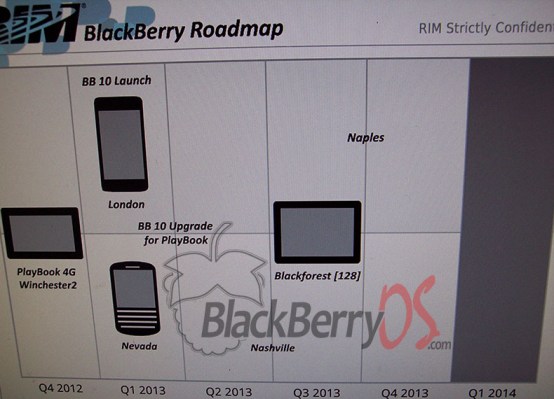Of all the disappointing details heard during RIM’s most recent earnings call, the company’s decision to push back the launch of its first BlackBerry 10 devices was among the most devastating to the company’s loyal legion of fans.
Bummer though it may be, we may now have a clearer view of RIM’s hardware plans for the next year thanks to a newly-leaked roadmap obtained by BlackBerryOS. You know the drill folks — have those grains of salt at the ready.
RIM CEO Thorsten Heins confirmed earlier this year that the first BlackBerry 10 device to launch would be a full touch device (the BlackBerry London/L-series), which would be followed shortly by a QWERTY handset (the Nevada/N-series). What Heins never disclosed was how quickly that second smartphone would launch after the first, but the slide confirms that both of them will be available at some point during Q1 2013.
Perhaps more interesting is the inclusion of a new tablet into the mix that’s apparently being prepared for release in the third quarter of next year. The slide is awfully light on details but the so-called Blackforest may sport 128GB of internal storage and appears significantly larger than the revamped 7-inch PlayBook 4G that’s slated to launch by the end of this year. It’s possible that the Blackforest could be the long-rumored 10-inch PlayBook, and if so, it seems as though the rumors of its demise have been exaggerated.
The slide is also peppered with a few other, less-detailed launches — something called the Nashville is expected to launch between Q2 and Q3, while RIM aims for a Q3/Q4 launch date for the Naples. Those names have popped up in the BlackBerry 10 Dev Alpha build so it’s pretty clear that they’re devices in the works, but there’s still no detail on what they’ll bring to the table.
If RIM’s plans for 2013 look a little sparse, it’s likely because RIM is looking to put more wood behind fewer arrows — as Heins stated during the earnings call, the company will have “fewer devices in a market at any given time.” It’s an approach that plenty of other smartphone players are running with these days, though only time will tell if they can survive this nasty transition period.
